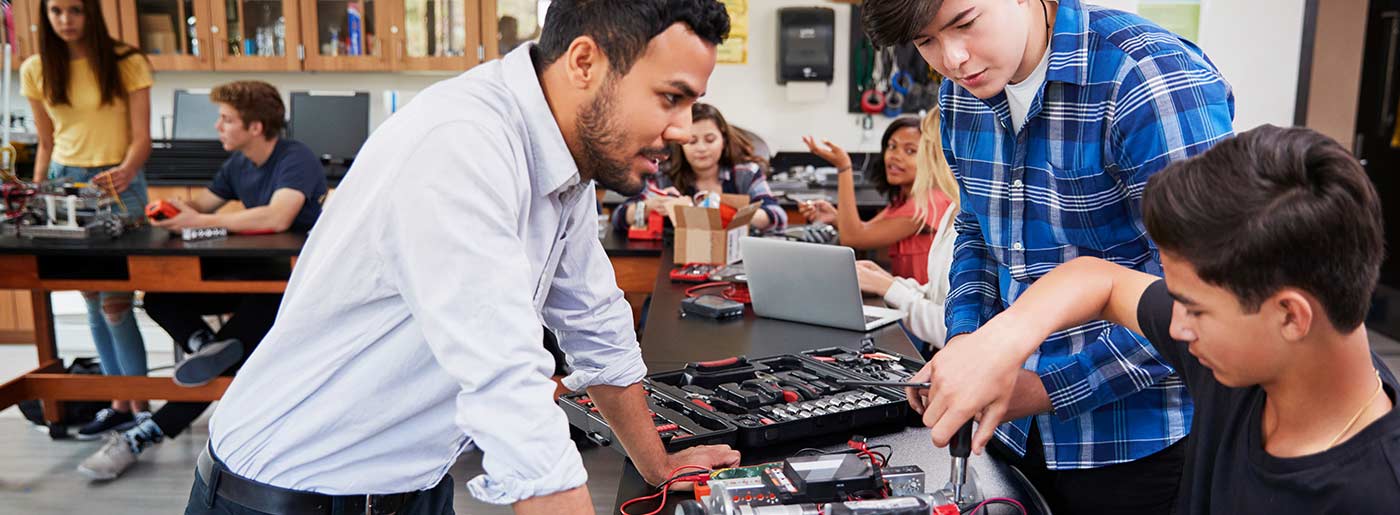Texas STEM Education Toolkit: Implementation Tools
TEA has developed three sets of tools to support Science, Technology, Engineering, and Mathematics (STEM) implementation in districts and campuses. The first set supports STEM classroom instructors, the second set enables self-reflection and assessment of STEM program effectiveness, and the third set is aimed at evaluating and enhancing the STEM climate and culture within educational settings.
Instructional Tools
Tools designed to guide instructors as they shift to an inquiry-based STEM approach in the classroom.
The STEM Instructional Planning Guide (PDF) equips educators with best practices for creating curricular units, lessons, and activities. It streamlines the curriculum development process and fosters student knowledge and skills through inquiry-based integrated units that culminate in an engineering design challenge. The templates can be tailored to the needs and abilities of students.
The STEM Teaching and Learning Progressions (PDF) tool is designed to guide instruction towards integrated education at organizational, school, or classroom levels. This involves a planned and extended implementation process. Skills are honed over time, starting as early as pre-kindergarten, and continuing through high school, shaped by instructional decisions. This tool offers educators an outline for scaffolding experiences, from the initial stages to more advanced application.
Engineering design challenges can be created for a specific standard or aligned with multiple standards and subject areas. This tool supports educators in developing cross-curricular engineering design challenges anchored in the science standards. Engineering practices are part of the student expectations in the Texas Essential Knowledge and Skills (TEKS) for science. However, an engineering design challenge can incorporate content from multiple subject areas to enable students to apply content to solve a real-world problem.
Kindergarten Developing an Engineering Design Challenge (PDF)
Grade 1 Developing an Engineering Design Challenge (PDF)
Grade 2 Developing an Engineering Design Challenge (PDF)
Grade 3 Developing an Engineering Design Challenge (PDF)
Grade 4 Developing an Engineering Design Challenge (PDF)
Grade 5 Developing an Engineering Design Challenge (PDF)
Integration Strategies (PDF) encourages viewing STEM as a cohesive entity that blends disciplines, emphasizing interconnections rather than divisions. Integration encompasses various collaborative approaches, each with distinct structures but a shared goal of linking concepts and skills across fields. This tool offers a comprehensive guide, clarifying definitions, and illustrates integration methods and strategies.
Use the Integration Planning Graphic Organizer (PDF) to aid in crafting integrated learning experiences in STEM. Complete the organizer by identifying the Texas Essential Knowledge and Skills (TEKS)-aligned content and fluency skills relevant to the lesson, unit, or project.
These STEM one-pagers are designed to clarify essential concepts in STEM education. They serve as a valuable tool for conveying the engineering components of the science TEKS to students, educators, and the broader community:
- Engineering Design Process (PDF)
- Engineering Design Components and Evaluation Process (PDF)
- Recurring Themes and Concepts (PDF)
- Recurring Themes and Concepts Posters 8.5x11 and 18x24 (PDF)
- Claims, Evidence, and Reasoning (CER) (PDF)
These STEM technology briefs support an understanding of key concepts in computing. These resources can be used for communicating with students, educators, and the community:
STEM Resources that Support the 2022 Technology Application TEKS
Reflection and Evaluation Tools
Tools that can be used to reflect on STEM lessons and evaluate programming from the classroom to district level.
The STEM Curricular Activity Reflection for Teachers (PDF) tool helps educators evaluate and enhance integrated curricular activities. It emphasizes the importance of reflection in the design process to refine and improve future iterations. This tool supports informing instructional choices and teaching practices. It offers guidance for individual or team reflections post-STEM activity implementation, with questions and a template to facilitate discussions on planning, instruction, assessments, and student learning outcomes.
The STEM Walk-Through Observational Tool (PDF) offers immediate, qualitative guidance for evaluators to provide constructive feedback to instructors during activity observations. It includes key observation points that align with the STEM Instructional Planning Guide (PDF). This tool serves as an informal formative assessment for personalized coaching, feedback, and for documenting and assessing program goals and outcomes.
The PK–20 STEM Education Fidelity of Implementation Rubric (PDF) is a tool designed for those overseeing the implementation of programs. It’s an analytical rubric that corresponds with the high-quality indicators of the PK–20 STEM Framework, distinguishing the various phases of a program’s maturity. Users will fill out a scorecard post-rubric to pinpoint strengths and growth areas for the program. This rubric is also useful for collecting initial data, assessing program effectiveness, and conducting annual reviews to gauge progress towards set objectives.
STEM Culture and Climate Tools
Tools developed to support a district’s STEM culture and climate through scaffolding teaching and learning, surveying stakeholders, and building fluency skills through instruction.
Shifting to integrated education within organizations, schools, or classrooms requires a comprehensive, long-term strategy. STEM skills are nurtured from pre-kindergarten through high school with strategic educational choices. The STEM Teaching and Learning Progressions (PDF) tool outlines how educators can build these experiences, progressing from basic to advanced levels of implementation.
Mastery in content areas is crucial for integrated education, which also encompasses skills vital for career preparedness and workforce development. The STEM Skills Fluency Rubric (PDF) tool outlines essential skills, offers a rubric for various developmental stages, and provides classroom examples to illustrate skill application.
These sample statements can be used to create customized surveys at the local level to assess teacher, student, and family interest in STEM education. Copy and paste statements into the survey tool of choice. The statements have been grouped for convenience and are designed to be used with a Likert Scale:
Michelle Sedberry
STEM Coordinator
Michelle.sedberry@tea.texas.gov


